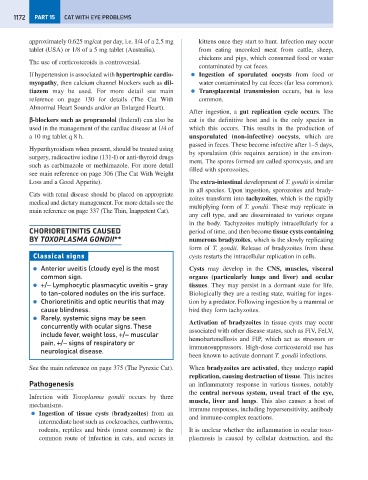Page 1180 - Problem-Based Feline Medicine
P. 1180
1172 PART 15 CAT WITH EYE PROBLEMS
approximately 0.625 mg/cat per day, i.e. 1/4 of a 2.5 mg kittens once they start to hunt. Infection may occur
tablet (USA) or 1/8 of a 5 mg tablet (Australia). from eating uncooked meat from cattle, sheep,
chickens and pigs, which consumed food or water
The use of corticosteroids is controversial.
contaminated by cat feces.
If hypertension is associated with hypertrophic cardio- ● Ingestion of sporulated oocysts from food or
myopathy, then calcium channel blockers such as dil- water contaminated by cat feces (far less common).
tiazem may be used. For more detail see main ● Transplacental transmission occurs, but is less
reference on page 130 for details (The Cat With common.
Abnormal Heart Sounds and/or an Enlarged Heart).
After ingestion, a gut replication cycle occurs. The
β-blockers such as propranolol (Inderal) can also be cat is the definitive host and is the only species in
used in the management of the cardiac disease at 1/4 of which this occurs. This results in the production of
a 10 mg tablet q 8 h. unsporulated (non-infective) oocysts, which are
passed in feces. These become infective after 1–5 days,
Hyperthyroidism when present, should be treated using
by sporulation (this requires aeration) in the environ-
surgery, radioactive iodine (131-I) or anti-thyroid drugs
ment. The spores formed are called sporocysts, and are
such as carbimazole or methimazole. For more detail
filled with sporozoites.
see main reference on page 306 (The Cat With Weight
Loss and a Good Appetite). The extra-intestinal development of T. gondii is similar
in all species. Upon ingestion, sporozoites and brady-
Cats with renal disease should be placed on appropriate
zoites transform into tachyzoites, which is the rapidly
medical and dietary management. For more details see the
multiplying form of T. gondii. These may replicate in
main reference on page 337 (The Thin, Inappetent Cat).
any cell type, and are disseminated to various organs
in the body. Tachyzoites multiply intracellularly for a
CHORIORETINITIS CAUSED period of time, and then become tissue cysts containing
BY TOXOPLASMA GONDII** numerous bradyzoites, which is the slowly replicating
form of T. gondii. Release of bradyzoites from these
Classical signs cysts restarts the intracellular replication in cells.
● Anterior uveitis (cloudy eye) is the most Cysts may develop in the CNS, muscles, visceral
common sign. organs (particularly lungs and liver) and ocular
● +/- Lymphocytic plasmacytic uveitis – gray tissues. They may persist in a dormant state for life.
to tan-colored nodules on the iris surface. Biologically they are a resting state, waiting for inges-
● Chorioretinitis and optic neuritis that may tion by a predator. Following ingestion by a mammal or
cause blindness. bird they form tachyzoites.
● Rarely, systemic signs may be seen
Activation of bradyzoites in tissue cysts may occur
concurrently with ocular signs. These
associated with other disease states, such as FIV, FeLV,
include fever, weight loss, +/- muscular
hemobartonellosis and FIP, which act as stressors or
pain, +/- signs of respiratory or
immunosuppressors. High-dose corticosteroid use has
neurological disease.
been known to activate dormant T. gondii infections.
See the main reference on page 375 (The Pyrexic Cat). When bradyzoites are activated, they undergo rapid
replication, causing destruction of tissue. This incites
Pathogenesis an inflammatory response in various tissues, notably
the central nervous system, uveal tract of the eye,
Infection with Toxoplasma gondii occurs by three
muscle, liver and lungs. This also causes a host of
mechanisms.
immune responses, including hypersensitivity, antibody
● Ingestion of tissue cysts (bradyzoites) from an
and immune-complex reactions.
intermediate host such as cockroaches, earthworms,
rodents, reptiles and birds (most common) is the It is unclear whether the inflammation in ocular toxo-
common route of infection in cats, and occurs in plasmosis is caused by cellular destruction, and the

